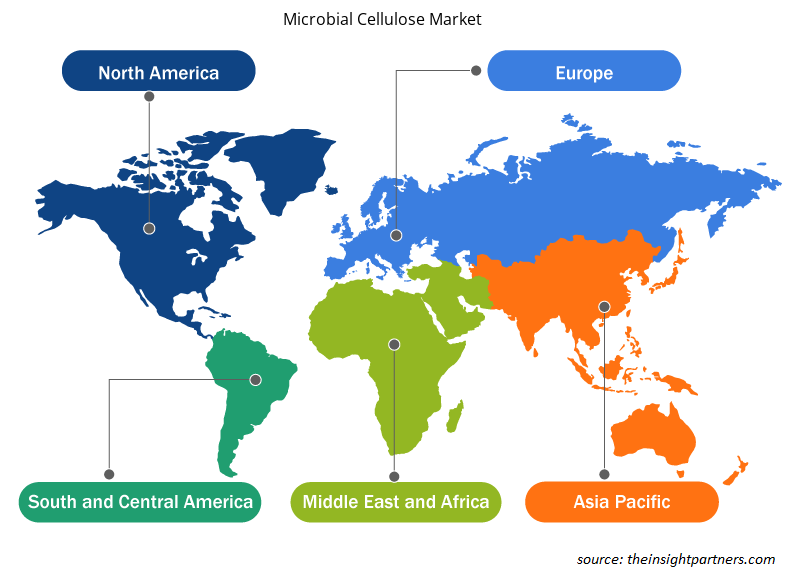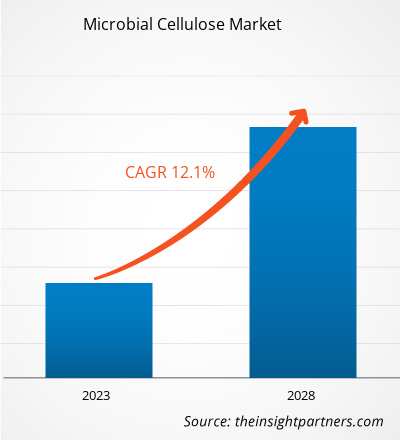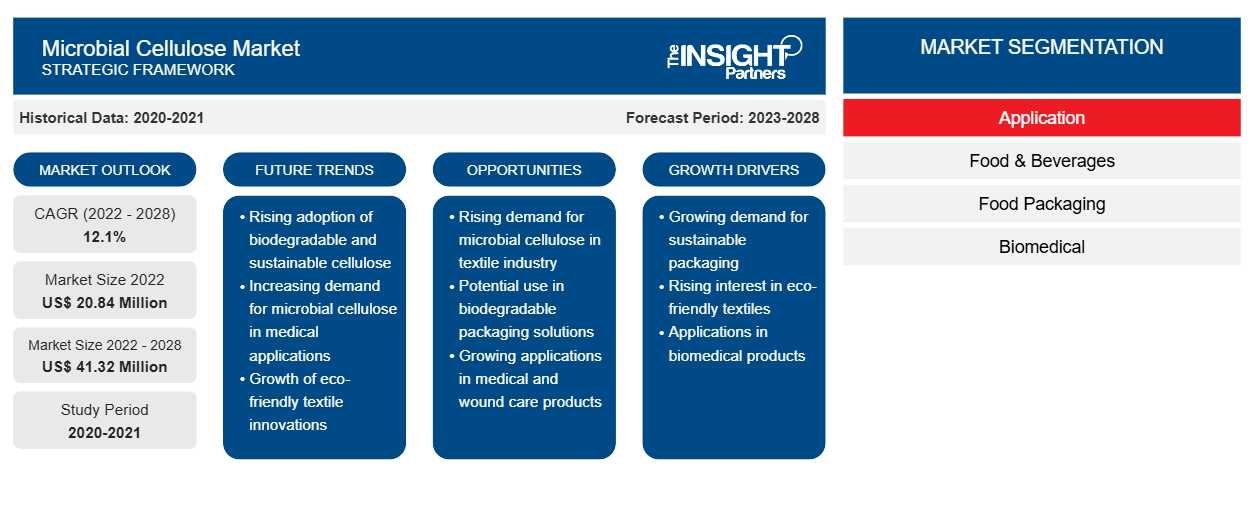[Rapporto di ricerca] Si prevede che il mercato della cellulosa microbica crescerà da 20,84 milioni di dollari nel 2022 a 41,32 milioni di dollari entro il 2028; si stima che registrerà un CAGR del 12,1% dal 2022 al 2028.
La cellulosa microbica è prodotta dalla fermentazione di terreni di coltura ricchi di glucosio e fruttosio come principali fonti di carbonio. La cellulosa microbica ha una maggiore resistenza alla trazione e capacità di trattenere l'acqua ed è biodegradabile a differenza della cellulosa vegetale, che è difficile da biodegradare. La cellulosa batterica ha anche un grado di polimerizzazione più elevato rispetto alla cellulosa vegetale, il che la rende altamente suscettibile alle fluttuazioni di temperatura ed è priva di lignina, emicellulosa e pectina. La cellulosa microbica sta guadagnando un'enorme popolarità come biomateriale in quanto è un'alternativa ecologica a varie plastiche convenzionali come polietilene e polipropilene. Viene anche utilizzata nell'industria biomedica per medicazioni per ferite e impianti medici. Pertanto, varie applicazioni della cellulosa microbica stanno guidando la crescita del mercato globale della cellulosa microbica .
Nel 2021, l'Asia Pacifica deteneva la quota maggiore del mercato globale della cellulosa microbica. Negli ultimi anni, la regione ha assistito a un aumento dell'inquinamento ambientale causato dalla produzione e dallo smaltimento improprio di cosmetici e prodotti per la cura della persona realizzati con materie prime contenenti sostanze tossiche. Secondo il rapporto di Frontiers Media SA, nell'Asia Pacifica, oltre il 70% dei cosmetici e dei prodotti per la cura della persona contiene almeno un tipo di microbo come ingrediente. Pertanto, la domanda di cellulosa microbica è in aumento nell'industria cosmetica della regione. Inoltre, l'industria cosmetica nel sud-est asiatico sta crescendo rapidamente a causa del crescente potere d'acquisto della popolazione e dell'aumento della popolazione della classe media. Pertanto, si prevede che tutti questi fattori stimoleranno la crescita del mercato della cellulosa microbica durante il periodo di previsione.
Personalizza questo report in base alle tue esigenze
Riceverai la personalizzazione gratuita di qualsiasi report, comprese parti di questo report, o analisi a livello nazionale, pacchetto dati Excel, oltre a usufruire di grandi offerte e sconti per start-up e università
- Scopri le principali tendenze di mercato in questo rapporto.Questo campione GRATUITO includerà analisi di dati che spaziano dalle tendenze di mercato alle stime e alle previsioni.
Impatto della pandemia di COVID-19 sul mercato della cellulosa microbica
Le industrie manifatturiere, comprese le aziende di cellulosa microbica, hanno dovuto affrontare sfide senza precedenti dopo l'emergere della pandemia di COVID-19 nel 2020 a causa di vincoli alla catena di fornitura causati da lockdown a livello nazionale, divieti commerciali e restrizioni di viaggio. Le interruzioni della catena di fornitura hanno creato una carenza di materie prime, che ha influenzato la produzione e la distribuzione di cellulosa microbica, portando a un aumento dei prezzi. Inoltre, un picco nella produzione di rifiuti medici a livello globale ha portato a preoccupazioni sulla sostenibilità tra consumatori, produttori e governi di vari paesi. C'era una domanda significativa di mascherine monouso realizzate in materiale non biodegradabile. Pertanto, i produttori hanno iniziato a esplorare diversi biopolimeri biodegradabili per realizzare mascherine. Questo fattore ha aperto nuove opportunità per i produttori di cellulosa microbica, poiché la cellulosa microbica possiede proprietà desiderabili per sostituire i materiali convenzionali utilizzati nelle mascherine.
Nel 2021, varie economie hanno ripreso le operazioni poiché i loro governi hanno annunciato allentamenti nelle restrizioni precedentemente imposte, il che ha dato impulso al mercato globale. Inoltre, ai produttori è stato consentito di operare a piena capacità, il che li ha aiutati a superare il divario tra domanda e offerta e altre ripercussioni.
Approfondimenti di mercato
Crescenti applicazioni nel settore cosmetico per alimentare la crescita del mercato della cellulosa microbica
I produttori di cosmetici stanno esplorando approcci e materiali innovativi per ridurre l'impatto ambientale. La cellulosa microbica è un materiale naturale e sostenibile elogiato dai produttori di cosmetici per la sua biocompatibilità, adesione cutanea e proprietà di ritenzione idrica. La cellulosa microbica è utilizzata principalmente per realizzare maschere in tessuto utilizzate nella cura della pelle. Queste maschere hanno proprietà di ritenzione idrica superiori grazie alla loro nanostruttura tridimensionale che assorbe ingredienti idrofili attivi come agenti anti-invecchiamento e idratanti. Le maschere viso biocellulosiche hanno anche forti proprietà di adesione cutanea, che aiutano a migliorare l'assorbimento o la penetrazione dei nutrienti nella pelle. Inoltre, le persone cercano prodotti che le aiutino ad apparire giovani e fresche. Sono disposte a spendere una cifra enorme in prodotti per la cura della pelle che rendano la loro pelle sana e radiosa. Le maschere in tessuto stanno riscuotendo un enorme successo tra i consumatori in quanto aiutano a ridurre linee sottili, rughe, acne e pigmentazione; ringiovanire la pelle; e aumentare l'idratazione. Si prevede che tutti questi fattori aumenteranno la domanda di cellulosa microbica nel settore cosmetico durante il periodo di previsione.
I principali attori che operano nel mercato globale della cellulosa microbica includono ScobyTec GmbH, BOWIL Biotech SP Zoo, Polybion SL, Bacpolyzyme Biyomuhendislik Ltd, Axcelon Biopolymers Corp, Bioweg UG, Cellulose Lab Inc, Bacterial Cellulose Solutions Inc, Ashland Inc e BIOINSPIRED MATERIALS SL. Gli attori del mercato si stanno concentrando sulla fornitura di prodotti di alta qualità per soddisfare la domanda dei clienti. Si stanno inoltre concentrando su strategie quali investimenti in attività di ricerca e sviluppo, partnership ed espansione.
Approfondimenti regionali sul mercato della cellulosa microbica
Le tendenze regionali e i fattori che influenzano il mercato della cellulosa microbica durante il periodo di previsione sono stati ampiamente spiegati dagli analisti di Insight Partners. Questa sezione discute anche i segmenti e la geografia del mercato della cellulosa microbica in Nord America, Europa, Asia Pacifico, Medio Oriente e Africa e America meridionale e centrale.

- Ottieni i dati specifici regionali per il mercato della cellulosa microbica
Ambito del rapporto sul mercato della cellulosa microbica
| Attributo del report | Dettagli |
|---|---|
| Dimensioni del mercato nel 2022 | 20,84 milioni di dollari USA |
| Dimensioni del mercato entro il 2028 | 41,32 milioni di dollari USA |
| CAGR globale (2022 - 2028) | 12,1% |
| Dati storici | 2020-2021 |
| Periodo di previsione | 2023-2028 |
| Segmenti coperti | Per applicazione
|
| Regioni e Paesi coperti | America del Nord
|
| Leader di mercato e profili aziendali chiave |
|
Densità degli attori del mercato della cellulosa microbica: comprendere il suo impatto sulle dinamiche aziendali
Il mercato della cellulosa microbica sta crescendo rapidamente, spinto dalla crescente domanda degli utenti finali dovuta a fattori quali l'evoluzione delle preferenze dei consumatori, i progressi tecnologici e una maggiore consapevolezza dei benefici del prodotto. Con l'aumento della domanda, le aziende stanno ampliando le loro offerte, innovando per soddisfare le esigenze dei consumatori e capitalizzando sulle tendenze emergenti, il che alimenta ulteriormente la crescita del mercato.
La densità degli operatori di mercato si riferisce alla distribuzione di aziende o società che operano in un particolare mercato o settore. Indica quanti concorrenti (operatori di mercato) sono presenti in un dato spazio di mercato in relazione alle sue dimensioni o al valore di mercato totale.
Le principali aziende che operano nel mercato della cellulosa microbica sono:
- Azienda
- Zoo di BOWIL Biotech SP
- Polibio SL
- Bacpolyzyme Biyomuhendislik Ltd
- Axcelon Biopolymers Corp
Disclaimer : le aziende elencate sopra non sono classificate secondo un ordine particolare.

- Ottieni una panoramica dei principali attori del mercato della cellulosa microbica
Sviluppo chiave
Nel febbraio 2023, Bioweg, una startup tedesca impegnata nella produzione di cellulosa microbica, e Ginkgo Bioworks, un'azienda che sviluppa piattaforme di programmazione cellulare e biosicurezza, hanno firmato un accordo di partnership per ottimizzare la produzione di cellulosa microbica e sviluppare nuove varianti di cellulosa in grado di sostituire le plastiche convenzionali.
Segnala i riflettori
- Tendenze industriali progressive nel mercato della cellulosa microbica per aiutare gli operatori a sviluppare strategie efficaci a lungo termine
- Strategie di crescita aziendale adottate dai paesi sviluppati e in via di sviluppo
- Analisi quantitativa del mercato della cellulosa microbica dal 2020 al 2028
- Stima della domanda globale di cellulosa microbica
- Analisi PEST per illustrare i fattori politici, economici, sociali e tecnologici che influenzano la crescita del mercato globale della cellulosa microbica.
- Sviluppi recenti per comprendere lo scenario competitivo del mercato
- Tendenze e prospettive di mercato, nonché fattori che guidano e frenano la crescita del mercato della cellulosa microbica
- Assistenza nel processo decisionale evidenziando le strategie di mercato che sostengono l'interesse commerciale, portando alla crescita del mercato
- Dimensioni del mercato della cellulosa microbica in vari nodi
- Panoramica dettagliata e segmentazione del mercato, nonché dinamiche del settore della cellulosa microbica
- Dimensioni del mercato della cellulosa microbica in varie regioni con promettenti opportunità di crescita
- Analisi storica (2 anni), anno base, previsione (7 anni) con CAGR
- Analisi PEST e SWOT
- Valore/volume delle dimensioni del mercato - Globale, Regionale, Nazionale
- Industria e panorama competitivo
- Set di dati Excel
Report recenti
Rapporti correlati
Testimonianze
Motivo dell'acquisto
- Processo decisionale informato
- Comprensione delle dinamiche di mercato
- Analisi competitiva
- Analisi dei clienti
- Previsioni di mercato
- Mitigazione del rischio
- Pianificazione strategica
- Giustificazione degli investimenti
- Identificazione dei mercati emergenti
- Miglioramento delle strategie di marketing
- Aumento dell'efficienza operativa
- Allineamento alle tendenze normative





















 Ottieni un campione gratuito per - Mercato della cellulosa microbica
Ottieni un campione gratuito per - Mercato della cellulosa microbica